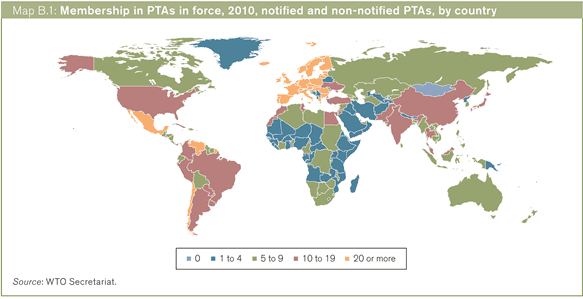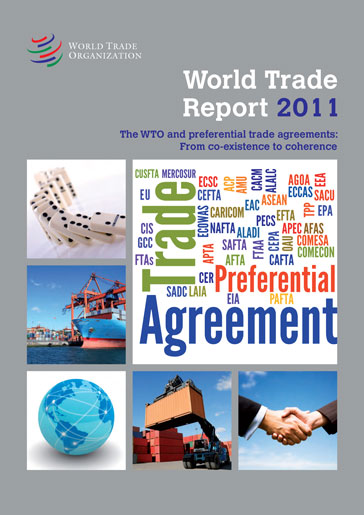The World Trade Report 2011 observes that these preferential trade agreements (PTAs) are becoming more complex, involving pacts between regions, as well as between countries or within regions.
But more significantly they are evolving towards deeper integration that goes beyond tariffs and other measures at national borders — they increasingly include domestic policies such as regulations on services and investment, intellectual property protection and competition policy, which the report calls “deep PTAs”.
“These trends raise vital questions about the focus and reach of the WTO, and the value assigned by governments to globally-based trade relations,” Director-General Pascal Lamy said.
The report argues that deep PTAs reflect important changes in the world economy such as the growth of global production networks. These networks require better regulation and supervision in a range of areas, and deeper PTAs may be addressing this need.
The result is that deeper PTAs can also benefit other countries rather than discriminating against them. On the one hand, lower preferential tariffs within these free trade agreements no longer offer much of an advantage because non-preferential tariffs (“most-favoured nation” or “MFN” in WTO jargon) are already low.
At the same time, if deep integration provisions require broader regulation, then these could apply to goods, services and investment from all countries, not just the members of the preferential agreements.
The World Trade Report 2011 describes PTAs’ historical development and their current landscape. It examines why they are established, their economic effects, their contents and the relationship between the agreements and the multilateral trading system.
Director-General Pascal Lamy says in his foreword: “I believe that to the extent that PTAs are motivated by a desire for deeper integration rather than market segmentation, there could be a role for the WTO to promote greater coherence among non-competing but divergent regulatory regimes that in practice cause geographical fragmentation or raise trade costs. There is no doubt that we need to build towards a more stable and healthier trading environment, where alternative trade policy approaches are mutually supportive and balance equitably the needs of all nations.”
Main points
Trends in PTAs
Countries’ participation in preferential trade agreements has accelerated over time, become more widespread and transcended regional boundaries. Half of the PTAs currently in force are not strictly “regional” as the growth of cross-regional PTAs has become particularly pronounced in the last decade. Free trade agreements are far more common than customs unions. At the same time, a number of products continue to be excluded from preferential access.
Preferential trade and margins
The explosion of PTAs is not being matched by an expansion in the trade flows that receive preferential treatment. This should not be surprising since tariffs have been reduced considerably since the end of the Second World War, reducing the significance of the preferential tariffs (the “preferential margins”).
PTAs can also be complicated by rules of origin (how authorities determine where a product originates and therefore whether it is eligible for preferential treatment). The costs that companies face in meeting the requirements can be higher than the benefit they perceive from the lower tariffs.
Preferential margins are also small when they are adjusted to account for the preferential access enjoyed by competing exporters. The proliferation of PTAs means that the difference between the basic non-preferential (“MFN”) rate and the PTA rate overstates the competitive advantage of a PTA member, since increasingly its competitors will also enjoy preferential access to the market.
Explanations of why countries enter into PTAs have to look beyond tariffs.
Deep PTAs
More and more PTAs are deep rather than shallow agreements. They include a wide range of issues beyond tariffs, such as services, investment, intellectual property protection, and competition policy. These policy areas involve domestic regulations (or behind-the-border measures).
Therefore the analysis may need a framework distinct from the more conventional assessments of trade creation and trade diversion because changes to domestic regulations are difficult to tailor so that they favour only selected trade partners.
Deep integration is likely to occur for several reasons. First, as trade becomes more open, countries’ policies increasingly depend on each other. As a result, unilateral decision-making is inefficient compared with decisions taken collectively.
Secondly, deep integration agreements may be necessary to promote trade in certain sectors and economic integration more broadly. This applies to international production networks which require a governance structure beyond low tariffs.
Coherence between PTAs and the WTO
Deep PTAs present a new challenge to the multilateral trading system. The view that these agreements may be building-blocks or stumbling-blocks for the global system was based on the underlying question of whether preferential tariff opening would eventually lead to multilateral opening. That does not fit well with deep PTAs.
The report identifies a number of options for increasing coherence between PTAs and the multilateral trading system. They include:
- fixing deficiencies in the WTO legal framework (i.e. a “hard law” approach)
- adopting a more nuanced and non-litigious approach to considering PTAs in the context of the WTO’s transparency and information exchange work — trying instead to understand better how countries’ interests in PTAs might also be multilaterally based (a “soft law” approach)
- accelerating a multilateral non-preferential (“MFN-driven”) agenda on trade opening and regulation
- multilateralizing regionalism, i.e. extending existing preferential arrangements in a non-discriminatory manner to additional parties.
Key facts
- Almost 300 preferential trade agreements (notified and not notified) were in force in 2010. On average, a WTO member is party to 13 PTAs.
- Despite the surge of PTAs in recent years, only 16% of global merchandise trade receives preferential treatment. In addition, less than 2% of world trade is eligible for preference margins above 10 percentage points.
- Non-preferential (MFN) tariffs are low, equal to 4% on average in 2009. Most “sensitive” sectors remain “sensitive” in PTAs: approximately 66% of tariff lines (products defined by their customs codes) with MFN rates above 15% have not been reduced in PTAs.
- If the preferential access enjoyed by other exporters is taken into account, less than 13% of preferential trade benefits from a competitive advantage exceeding 2 percentage points.
- Signing deep integration PTAs increases trade in production networks by almost 8% on average. In addition, a high level of trade in production networks raises the likelihood of signing deep agreements.
- A large number of disputes between PTA members are brought to the WTO dispute settlement system. On average, about 30% of WTO disputes are between members who are parties to the same PTA.
> Problems viewing this page?
Please contact [email protected] giving details of the operating system and web browser you are using.


